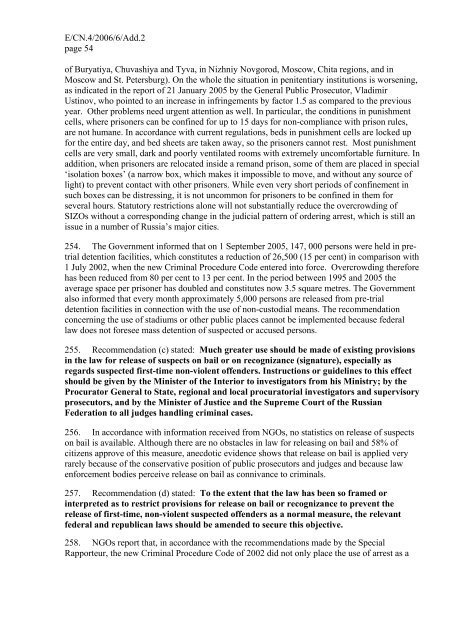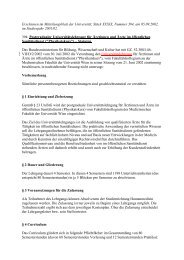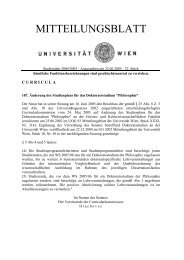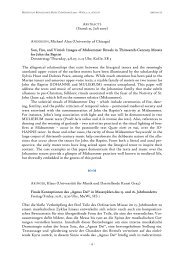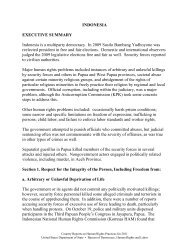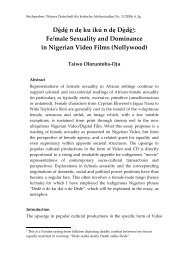E Economic and Social Council - acnudh
E Economic and Social Council - acnudh
E Economic and Social Council - acnudh
Create successful ePaper yourself
Turn your PDF publications into a flip-book with our unique Google optimized e-Paper software.
E/CN.4/2006/6/Add.2<br />
page 54<br />
of Buryatiya, Chuvashiya <strong>and</strong> Тyva, in Nizhniy Novgorod, Moscow, Chita regions, <strong>and</strong> in<br />
Moscow <strong>and</strong> St. Petersburg). On the whole the situation in penitentiary institutions is worsening,<br />
as indicated in the report of 21 January 2005 by the General Public Prosecutor, Vladimir<br />
Ustinov, who pointed to an increase in infringements by factor 1.5 as compared to the previous<br />
year. Other problems need urgent attention as well. In particular, the conditions in punishment<br />
cells, where prisoners can be confined for up to 15 days for non-compliance with prison rules,<br />
are not humane. In accordance with current regulations, beds in punishment cells are locked up<br />
for the entire day, <strong>and</strong> bed sheets are taken away, so the prisoners cannot rest. Most punishment<br />
cells are very small, dark <strong>and</strong> poorly ventilated rooms with extremely uncomfortable furniture. In<br />
addition, when prisoners are relocated inside a rem<strong>and</strong> prison, some of them are placed in special<br />
‘isolation boxes’ (a narrow box, which makes it impossible to move, <strong>and</strong> without any source of<br />
light) to prevent contact with other prisoners. While even very short periods of confinement in<br />
such boxes can be distressing, it is not uncommon for prisoners to be confined in them for<br />
several hours. Statutory restrictions alone will not substantially reduce the overcrowding of<br />
SIZOs without a corresponding change in the judicial pattern of ordering arrest, which is still an<br />
issue in a number of Russia’s major cities.<br />
254. The Government informed that on 1 September 2005, 147, 000 persons were held in pretrial<br />
detention facilities, which constitutes a reduction of 26,500 (15 per cent) in comparison with<br />
1 July 2002, when the new Criminal Procedure Code entered into force. Overcrowding therefore<br />
has been reduced from 80 per cent to 13 per cent. In the period between 1995 <strong>and</strong> 2005 the<br />
average space per prisoner has doubled <strong>and</strong> constitutes now 3.5 square metres. The Government<br />
also informed that every month approximately 5,000 persons are released from pre-trial<br />
detention facilities in connection with the use of non-custodial means. The recommendation<br />
concerning the use of stadiums or other public places cannot be implemented because federal<br />
law does not foresee mass detention of suspected or accused persons.<br />
255. Recommendation (c) stated: Much greater use should be made of existing provisions<br />
in the law for release of suspects on bail or on recognizance (signature), especially as<br />
regards suspected first-time non-violent offenders. Instructions or guidelines to this effect<br />
should be given by the Minister of the Interior to investigators from his Ministry; by the<br />
Procurator General to State, regional <strong>and</strong> local procuratorial investigators <strong>and</strong> supervisory<br />
prosecutors, <strong>and</strong> by the Minister of Justice <strong>and</strong> the Supreme Court of the Russian<br />
Federation to all judges h<strong>and</strong>ling criminal cases.<br />
256. In accordance with information received from NGOs, no statistics on release of suspects<br />
on bail is available. Although there are no obstacles in law for releasing on bail <strong>and</strong> 58% of<br />
citizens approve of this measure, anecdotic evidence shows that release on bail is applied very<br />
rarely because of the conservative position of public prosecutors <strong>and</strong> judges <strong>and</strong> because law<br />
enforcement bodies perceive release on bail as connivance to criminals.<br />
257. Recommendation (d) stated: To the extent that the law has been so framed or<br />
interpreted as to restrict provisions for release on bail or recognizance to prevent the<br />
release of first-time, non-violent suspected offenders as a normal measure, the relevant<br />
federal <strong>and</strong> republican laws should be amended to secure this objective.<br />
258. NGOs report that, in accordance with the recommendations made by the Special<br />
Rapporteur, the new Criminal Procedure Code of 2002 did not only place the use of arrest as a


